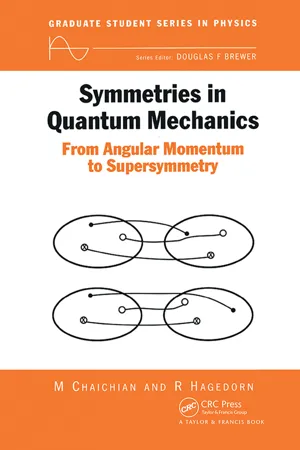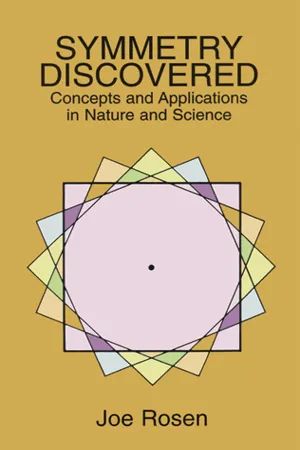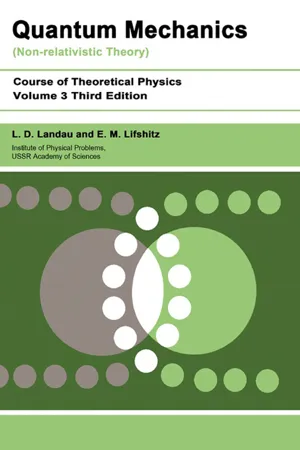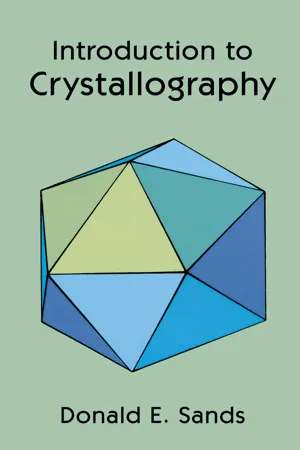Mathematics
Symmetry
Symmetry refers to a balanced and harmonious arrangement of parts or elements. In mathematics, symmetry is the concept of an object or a function remaining unchanged when subjected to a specific operation, such as reflection, rotation, or translation. It plays a fundamental role in various mathematical disciplines, including geometry, group theory, and algebra.
Written by Perlego with AI-assistance
Related key terms
Related key terms
1 of 4
Related key terms
1 of 3
12 Key excerpts on "Symmetry"
- eBook - ePub
Gigantic Challenges, Nano Solutions
The Science and Engineering of Nanoscale Systems
- Maher S. Amer(Author)
- 2021(Publication Date)
- Jenny Stanford Publishing(Publisher)
Symmetry and Symmetry Operations6.1 Introduction
Symmetry is such an amazing natural concept. It can be observed in almost everything around us including, not surprisingly, ourselves. Everyone knows that our right half is indistinguishable from our left half if reflected in a mirror. Nature used Symmetry billions of years before man and must have taught mankind how to understand Symmetry and use it. The German mathematician Hermann Weyl (1885–1955) said that through Symmetry, man always tried to perceive and create order, beauty, and perfection. The correlation between Symmetry and beauty would become clear if one was ever moved by the Symmetry, or beauty, of a snowflake, a crystal, or a flower. Ancient Greeks used the term Symmetry to describe “proportionality” or similarity in arrangements of parts. They applied such understanding to create the most beautiful sculptures for humanity. Symmetry and beauty can also be heard in music and poetry. In the broadest sense, Symmetry can be defined as the opposite of chaos and randomness. This definition of Symmetry drags attention to the deep relationship between Symmetry and entropy—a subject that is beyond the scope of this section.The mathematical formulation of Symmetry was rigorously developed in the 19th century. According to Hermann Weyl, an object is called symmetrical if it can be changed “somehow” to obtain the same object. In this section we will explain what is meant by “somehow,” and discuss the mathematical description of Symmetry as related to molecules and crystals, the building blocks of materials. The mathematical description of Symmetry is concerned with the correspondence of positions on opposite sides of a point, a line, or a plane. Mathematicians realized that at most, five different elements of Symmetry are needed to fully describe the correspondence of two point positions. In other words, one would need at most five different elements of Symmetry that once operated separately on a point, the point can be moved to a new indistinguishable position. To correlate this concept more closely with molecules, one may note that every molecule would possess one or more Symmetry elements that once operated the molecule will assume a new configuration indistinguishable from the original one. Hence, the “somehow” - eBook - ePub
- Jan C.A. Boeyens(Author)
- 2005(Publication Date)
- Elsevier Science(Publisher)
Ideas originating from a study of electromagnetism, mechanics, thermodynamics and other diverse fields may well appear to be unrelated until they are seen to be based on common laws dictated by the vacuum structure and the Symmetry of space-time. Proper understanding of this implied synthesis of ideas, requires familiarity with the concepts of group theory, fields, waves, particulate matter, relativity, quantum mechanics, phase relationships and solid-state theory. It may be rewarding to have a new look at science as a unified pursuit, against this background. The first objective will be to get a clear understanding of the Symmetry concept itself and to eliminate any confusion that may arise from its use in different contexts. There are symmetrical objects and operations, internal Symmetry and Symmetry in the laws of physics. These different symmetries may be discrete or continuous and be of either finite or infinite order.1.2 Group Theory and Symmetry
Although group theory formally is a branch of abstract mathematics its development has been linked intimately with concepts and operations related to the Symmetry of physical objects and structures.The concept of Symmetry is of ancient vintage and in many ways almost identical with the equally elusive concepts of beauty and harmony, i.e . beauty of form arising from balanced proportions. Although Symmetry can be described in mathematically precise terms, Symmetry in the physical world, like beauty1 , never absolutely obeys the mathematical requirements of group theory: even the most perfect crystal has a surface that spoils the Symmetry.It will be argued that any interaction represents a broken Symmetry and that mathematically precise Symmetry never occurs in the real world. The implication is that the almost magical parallel between mathematics and physics that fascinates both scientists and philosophers, breaks down at the most fundamental level. This observation has little or no impact on the analysis of physical systems (e.g - eBook - ePub
- Lines M E(Author)
- 2017(Publication Date)
- CRC Press(Publisher)
8 Symmetry: from Galois to SuperstringsSymmetry manifests itself in the physical world in many different ways, some very easy to appreciate and others quite difficult. It is somewhat unfortunate (for our normal chronological presentation of the development of the mathematics supporting important breakthroughs in physics) that the mathematical formalism that first revealed the enormous power of ‘Symmetry’ arose in one of the less visual contexts—namely, the theory of polynomial equations. It is also true that the mathematical expression of the consequences of Symmetry introduces concepts and operations that are unfamiliar to most ‘amateurs’. As a consequence, it is often said that the formal theory of Symmetry, or ‘group theory’ as it is now commonly known, is like garlic in that it is almost impossible to have a little bit of it. Although I can appreciate this sentiment, I do not think that it is necessarily true if our introduction turns away from the historical development of the subject, and our initial attention is focused upon the simplest of all possible symmetries both to envisage and to represent in mathematical terms.The Symmetry in question is a geometric one (geometric symmetries being by far the simplest of symmetries for the nonexpert to appreciate) and is perhaps the most common of all symmetries in nature. It is reflection Symmetry. If, for example, you hold a mirror perpendicular to this page and parallel to the long edge of the page, then most of the letters in the mirror will look strange, but a few (like M, W, o, v, and x) will remain quite recognizable. What characterizes the latter is the fact that they do not change their appearance when reflected about a line (or plane to be more precise) running down their middle. We say that they possess a reflection Symmetry about this plane or, more generally, that they exhibit a ‘bilateral’ Symmetry. So many objects around us have this Symmetry in an exact (e.g. balls, cups and saucers, wheelbarrows) or approximate (cats, dogs, cars, trees, ourselves) form that when we look in a mirror it is not immediately obvious that, in the mirror, right has changed into left and vice versa - eBook - ePub
Why Symmetry Runs The Positive Circular Economy
Underpinned by the deep, symmetric wisdom of Rav Yehuda Ashlag, Albert Einstein, Emmy Noether & Benjamin Graham
- George Hohbach(Author)
- 2021(Publication Date)
- Books on Demand(Publisher)
(Our Mathematical Universe, 2014, pp. 258-259)“Symmetry is evident all around us (…) a ball looks unchanged as you turn it around (…) In physics, Symmetry manifests in much the same way. If we do something to an equation but the equation doesn’t change, then the thing we did is said to be a Symmetry of the equation.”Brian Cox & Jeff Forshaw (Why does E=mc²?, 2009, p.187)Let’s write down this stunningly simple concept (mathematical configuration, equation, piece of information, structure) of equality, equivalence, sameness, Symmetry which was scientifically, with the help of mathematics, discovered in Nature and that Albert Einstein focused on.Or even more mathematically simplified (more generalized):This is the most abstract, purely mathematical STRUCTURE representing immaterial, creative wholeness as we will now discover. So, Nature, e.g., via its massive objects, presents this simple mathematical MASTER EQUATION (unity, wholeness, statement, state of being) to all equally informed observers. This was the equation on which Einstein focused.Since equality denotes UNITY, these two identical masses (exhibiting the same quantity), appear as ONE MASSIVE OBJECT (unity, unit, wholeness).Nature is mathematical at its core, as it literally implements Symmetry (equality) in a basically infinite number of massive objects.So, as I hope you have already been doing with the bold words and words in brackets, the fun is learning to see what is synonymous (the same as) to the word Symmetry and why or how. Mathematics is also a language, a very abstract - eBook - ePub
Symmetries in Quantum Mechanics
From Angular Momentum to Supersymmetry (PBK)
- M Chaichian, R Hagedorn(Authors)
- 2023(Publication Date)
- CRC Press(Publisher)
2 Symmetry in Quantum Mechanics2.1 Definition of Symmetry
2.1.1 General considerations
Consider any given structure—whether a physical system or a geometrical figure, a set of rules, an equation or a set of points in abstract space—whatever it may be, we only require the possibility of its mathematical description. Such a structure can always be cast in the following abstract form: it contains elements with names such as ‘electron’, ‘angle’, ‘sequence’, ‘five’ or ‘vector’ and it contains relations between these elements. Obviously the relations are the important things, for if two structures happen to contain different elements but the same relations, then knowing these relations we know everything about both structures. It might well happen that the relations of one structure are considered as elements of another structure when things are described on a higher level. In any case, the elements of a given structure can be represented by points in an abstract space. We then consider transformations in that space. Among all possible transformations in that space there might be a group of transformations which leave the relations between the points unaffected. We say the relations are invariant under this particular group of transformations and we call this group the Symmetry group of our structure. Very different structures may have the same Symmetry group; therefore, a Symmetry group is itself a new independent structure with elements (the transformations considered above) and relations (namely the group properties and the particular law of multiplication of that group). This leads to the consideration of the various Symmetry groups as abstract mathematical objects (e.g. the permutation group, Lorentz group, gauge group etc); individual realizations of these groups (e.g. the hydrogen molecule, the free particle of spin ½, the Lagrangian of charged particles—to mention only examples corresponding to the groups just mentioned)—such realizations are not considered in the study of abstract groups. - eBook - ePub
- Michael Hann(Author)
- 2019(Publication Date)
- CRC Press(Publisher)
Chapter 5 Symmetry 5.1 IntroductionIt is recognised commonly that Symmetry is a dominant structural feature found throughout the natural, built and manufactured environments. Embellishing objects with symmetrical images has been practised for thousands of years, but precisely when the first symmetrical images were produced remains unrecorded and is still debated. A concise, though well-focused, review was provided by Hahn (1998). In the late-twentieth century, a two-volume compendium, edited by Hargittai (1986, 1989), contained more than 100 papers, each focused on one aspect of the subject and, in the early twenty-first century, an extensive bibliography, taken from a surprisingly wide range of subject disciplines, was published by Washburn and Crowe (2004). So, the phenomenon manifests itself in a wide range of contexts. In the popular imagination, Symmetry is considered to be present when an object, image or motif consists of two component parts, one a reflection of the other. While the two parts are of equal weight, the contents and shape may be oriented in opposite directions; still, in the bulk of literature, each reflected component is regarded as ‘equal’ (and, occasionally, it is indeed the case that component parts of a symmetrical whole are actually indistinguishable visually, as would be the case with a reflection axis through the midway points at opposite sides of a square).So, in popular understanding, the word ‘Symmetry’ is used to refer specifically to reflection Symmetry, particularly where all parts on the left-hand side of an imaginary (two-sided) mirror are reflections to all parts on the right-hand side. This is known as ‘reflection Symmetry’, with one reflection only. However, higher orders of reflection Symmetry are possible, using two, three or more reflection axes. Visualisation is helped if each object, motif or figure is imagined as inscribed within a circle; each successive reflection axis reflects from two sides and is imagined as passing through the centre of that circle. So, in the popular imagination, at least, shapes or objects may be described as ‘symmetrical’ if they can be split into two or more reflected parts. - eBook - ePub
Symmetry Discovered
Concepts and Applications in Nature and Science
- Joe Rosen(Author)
- 2012(Publication Date)
- Dover Publications(Publisher)
3Geometric Symmetry
Geometric Symmetry is Symmetry with respect to geometric transformations. A geometric transformation is any transformation that affects only the geometric properties of a system. This is the kind of Symmetry that is usually alluded to, when the word ‘Symmetry’ is mentioned in everyday conversation. It is then related to features such as balance, regularity, order, repetition, proportionality, harmony and similarity. As we emphasized in the first chapter, the concept of Symmetry is much broader and more general than just geometric Symmetry. But geometric Symmetry is obviously important, and it is well worth our while to increase our understanding of it. This is what we attempt to accomplish in the present chapter. References are listed under GEO in the bibliography, including cross-references.The space with which we are familiar, in which we live, objects exist and events occur, is 3-dimensional. All real systems are 3-dimensional, and geometric transformations can affect them 3-dimensionally. Abstract systems having geometric properties, though, do not have to be 3-dimensional, but can be 2- or 1-dimensional. (As long as they are abstract, they can even be 4-dimensional or n -dimensional, but we do not concern ourselves with these here.) The square of chapter 1, for example, has no thickness and so is a 2-dimensional system. And even real systems might be considered as being 2- or 1-dimensional, when one or two of their dimensions can be ignored for the purposes of the discussion. For instance we can treat a length of pipe as a 1-dimensional system, if we are only interested in symmetries related to its longitudinal dimension. But we can also think of the same length of pipe as a 2-dimensional system, if we are only investigating the shape of its cross-section. It is convenient to consider separately the geometric symmetries of 1-, 2- and 3-dimensional systems. We refer to these respectively as linear , planar and spatial - Rakshit Ameta, Suresh C. Ameta(Authors)
- 2016(Publication Date)
- Apple Academic Press(Publisher)
Broadly speaking, group theory is a study of Symmetry. When one is dealing with an object that appears symmetric, group theory can help us with its analysis. As the structure and behavior of molecules and crystals depend on their different symmetries, group theory becomes an essential tool in many areas of chemistry like hybridization, molecular vibration, spectroscopy, molecular orbital theory, etc. Various scientists have excellently presented this subject from time to time.Apart from chemical applications of group theory, it has been also applied to robotics, computers, medical image analysis, crystallography, mathematical music theory, statistics, cosmological, stellar and atomic particle abstractions, modeling of vibrational modes of virus, molecular systems biology, mathematical biology, spectroscopy, etc.1.2 Symmetry
Symmetry is a kind of balancing act, which generates beauty in anything, a picture, material, molecule, etc. although Symmetry alone may not be enough to substantiate beauty. Its presence gives us a sense of beauty. In Koeslter’s words “Artists treat facts as stimuli for the imagination, while scientists use their imagination to coordinate facts.”Symmetry becomes quite important, when it interprets the facts and delights us particularly, when it limits our study of chemistry with the world of order, pattern, beauty and satisfaction. As a matter of fact, chemistry, like any other science, resembles the art and the chemist has a potential of creativity.1.2.1 Symmetry IN NATURE
There is a well-known proverb that “God always geometrizes.” Symmetry is present all over the world, i.e., in plant, animals, architecture, etc.(i) Plants
Plants have symmetric structures in their components like leaves, fruits, seeds, flowers, etc., mostly a radial Symmetry. Coniferous plants show cone shape Symmetry. Parts of the plants such as leaves, flowers, fruits, etc. are the best examples of bilateral, radial and multidimensional symmetries. The Symmetry present in flower makes it beautiful to look at. Here are few examples,- eBook - ePub
Electronic Structure and Properties of Transition Metal Compounds
Introduction to the Theory
- Isaac B. Bersuker(Author)
- 2010(Publication Date)
- Wiley(Publisher)
3 Symmetry Ideas and Group-Theoretical Description In the theory of electronic structure and properties of transition metal coordination compounds the ideas of Symmetry are of great, sometimes fundamental importance.The most complete description of Symmetry properties is achieved in the mathematical group theory. In this chapter we give minimum information about some rules worked out by group-theoretical methods that are required for a better understanding of the presentation in this book (for more details on group theory see, e.g., Refs. 1, 2, 3, 4, 5, 6, 7, 8).3.1 Symmetry Transformations and MatricesMolecular Symmetry is the property of a molecule to remain invariant under certain rotations and reflections in space and permutations of identical particles. These rotations, reflections, and permutations are called Symmetry operations, or Symmetry transformations . For instance, in the equilateral planar-triangular configuration of the molecule V 3 , the Symmetry transformations are (Fig. 3.1 ) rotations around the Oz axis (which is perpendicular to the plane of the molecule) by angles 2π/3, 4π/3, 2π, and around the axes A 1 B 1 , A 2 B 2 , and A 3 B 3 by angles π and 2π, as well as reflection in the planes that comprise these axes and are perpendicular to the plane of the molecule, and reflection in the plane of the triangle.Figure 3.1 Symmetry elements of an equilateral triangle.For the simplest Symmetry operations in space, namely, rotation and reflections (for crystals there are also translations), there are conventional notations. The rotation around some axis by the angle 2π/n is denoted by C n . It is obvious that if, after some rotation, the molecule is matched with itself, it will behave in the same way when this rotation is repeated an integer number of times.The result of consequent performance of two Symmetry operations is defined as their product . If C n is a Symmetry operation of the molecule, then is also a Symmetry operation. In general, C p with any integer p is also a Symmetry operation. In particular, is a rotation by an angle 2π that does not change the position of the molecule in space; this is the identical operation E ; hence . The axis of rotation in the C n operation is called the Symmetry axis of the order n , or n - eBook - ePub
Quantum Mechanics
Non-Relativistic Theory
- L D Landau, E.M. Lifshitz(Authors)
- 1981(Publication Date)
- Butterworth-Heinemann(Publisher)
However, in quantum-mechanical applications it is more convenient to regard Symmetry transformations as transformations of the coordinates which leave the Hamiltonian of the system in question invariant. It is obvious that, if the system is left unaltered by some rotation or reflection, the corresponding transformation of the coordinates does not change its Schrödinger’s equation. Thus we shall speak of a transformation group with respect to which a given Schrödinger’s equation is invariant. † Symmetry groups are conveniently studied with the help of the general mathematical techniques of what is called group theory, the fundamentals of which we shall explain below. At first we shall consider groups, each of which contains a finite number of transformations (known as finite groups). Each of the transformations forming a group is said to be an element of the group. Symmetry groups have the following important properties. Each group contains the identical transformation E (called the unit element of the group). The elements of a group can be multiplied by one another; by the product of two (or more) transformations we mean the result of applying them in succession. It is obvious that the product of any two elements of a group is also an element of that group. For the multiplication of elements we have the associative law (AB) C = A (BC), where A, B, C are elements of a group. There is evidently no general commutative law; in general, AB ≠ BA. For each element A of a group there is in the same group an inverse element A −1 (the inverse transformation), such that AA −1 = E. In some cases an element may be its own inverse; in particular, E −1 = E - eBook - ePub
- Donald E. Sands(Author)
- 2012(Publication Date)
- Dover Publications(Publisher)
Some of the earliest studies of crystals were motivated by observations of their external Symmetry. Snowflakes have hexagonal shapes; sodium chloride forms perfect cubes; and crystals of alum are frequently regular octahedra. Our study of crystallography will show us that these symmetrical shapes are manifestations of the internal structures of crystals. If the individual molecules have Symmetry, then it is perhaps reasonable that they should pack together in a symmetrical array. There are some complicating factors, however, in the actual development of a crystal, and the arrangement of molecules is influenced by the availability of space as well as by the Symmetry of the intermolecular forces. In the case of the very symmetrical benzene molecule, for example, it may turn out that six additional benzene molecules cannot approach closely from six equivalent directions without interfering with each other. Some of the molecules tilt to achieve a balance of attractive and repulsive forces, and the aggregate has less Symmetry than the single molecule. In energy terms, the potential energy minimum is associated with a lower Symmetry. It is also possible to have crystalline arrays where the Symmetry is higher than that of the individual molecules, and we will encounter examples of this as we proceed. The important point here is that Symmetry in crystals is a result of essentially the same factors that make crystallinity the natural state of a solid particle. If we have learned not to be surprised that solid matter is crystalline, then we must also accept the appearance of Symmetry as an inevitable consequence of some rather simple laws. We will eventually see that crystallinity itself may be regarded as a special type of Symmetry.The utility of Symmetry considerations extends beyond their application to crystals. For example, it is extremely useful to know that all six carbon atoms in a benzene molecule are identical (related by Symmetry), and calculations pertaining to molecular vibrations or chemical bonding are vastly simplified by taking such Symmetry into account. For this reason, we will devote this chapter to a general discussion of Symmetry concepts and nomenclature, especially as applied to molecules. This material is indispensable to our later treatment of crystal geometry and Symmetry; it is hoped that it will also provide some background for those who want to learn more about the role of Symmetry in chemistry.52-2 Definition of Symmetry
So far we have spoken of Symmetry as though everyone knew what is meant by the term. This is probably true, at least qualitatively, but a definition will ensure a common understanding of the Symmetry concept. An object or figure is said to have Symmetry if some movement of the figure or operation on the figure leaves it in a position indistinguishable from its original position. That is, inspection of the object and its surroundings will not reveal whether or not the operation has been carried out.2-3 Symmetry operations and elements of Symmetry
A molecule of H2 O is shown in Fig. 2-1 . The H—O—H angle is 104.5°, and the dotted line in the picture is the bisector of this angle. Suppose that the H2 O molecule is rotated 180° about the axis represented by the dotted line. The oxygen atom will be rotated 180°, but it will end up looking exactly as it did before the rotation. The two hydrogen atoms will be exchanged, so that now H(2) is on the left and H(1) is on the right. However, there is no possible way of telling the hydrogen atoms apart, since all hydrogens atoms are identical and in this molecule they have identical chemical environments. The 180° rotation has left the molecule in a position indistinguishable from its original position, so our definition of Symmetry is satisfied. In H2 O the 180° rotation about the bisector of the H—O—H angle is a Symmetry operation, and the rotation axis is a Symmetry element. This particular Symmetry element is designated by the symbol C2 in the Schoenflies notation used extensively by spectroscopists, or simply by the symbol 2 in the Hermann-Mauguin or international notation preferred by crystallographers. Besides designating the Symmetry element, the symbol C 2 - eBook - ePub
- Patrick Spread(Author)
- 2012(Publication Date)
- Routledge(Publisher)
At its simplest, a new door must fit its aperture, so the new door must have the same four symmetries of a rectangle as does the aperture. 26 Similarly the other symmetries of the assembly will have counterparts in the mathematics of Symmetry. The complexity need not invalidate the principle. Pattern recognition enables us to deal sensually with massive amounts of data. We negotiated the jungle through the recognition of symmetries; so we probably negotiate the supermarket and department store in the same way. It is possible that, while we are sensually aware of symmetries, the brain is processing sense data by means of Symmetry groups, like the four symmetries of the rectangle, as computers process using the binary system. Binary code is in itself simple, but in accumulation it accounts for great complexity. Symmetry transformations are also simple, apparently trivial, but in accumulation they produce extreme complexity. The mind is often likened to a computer – the idea of artificial intelligence is based on the analogy. In some of its processes the mind seems to function like a Symmetry computer. When we are shopping for socks, our mental Symmetry computer matches observed socks to the Symmetry group of socks retained in the computer. What seems impossible complexity is tempered by the limits on geometric symmetries. As has been seen, there are just seventeen underlying geometric symmetries, with a further forty-six symmetries if permutations of two colours are included. 27 If we process by Symmetry groups, we will be able to pick out symmetries when hanging by our heels from a tree. The efficiency of Symmetry Symmetry incorporates principles of efficiency. The symmetrical way is the efficient way, in that actions ordered with Symmetry are actions that use the least input in effort or material to achieve any given outcome
Index pages curate the most relevant extracts from our library of academic textbooks. They’ve been created using an in-house natural language model (NLM), each adding context and meaning to key research topics.
Explore more topic indexes
Explore more topic indexes
1 of 6
Explore more topic indexes
1 of 4











